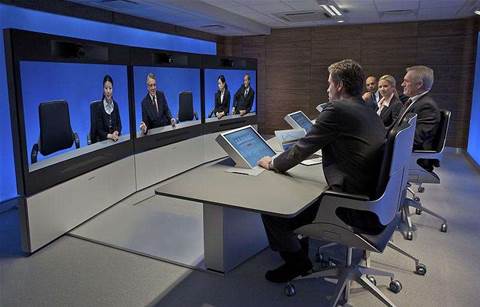From Telephonoscope to telepresence
1878 Thomas Edison formulated his idea for a "Telephonoscope" to allow people to talk and see each other over distance. It was illustrated by George du Maurier.
1891 Alexander Graham Bell hypothesised a video telephone in On The Possibility of Seeing by Electricity.
November 14, 1920 First US demonstration of the video phone between New York and St Louis.
April 7, 1927 US Commerce Secretary Herbert Hoover used a Bell Labs device to project his moving image to a New York audience.
1936 German post office's videoconferencing system connects customers in Berlin and outlying areas.
1939 Demonstration video phone call at World's Fair.
1956 Bell Labs (AT&T) built first PicturePhone video phone test system.
June, 1964 AT&T Picturephone "Mod 1" demonstrated at World's Fair. Calling booths established in New York, Washington DC and Chicago (three minutes for $US16-$US27).
1965 AT&T distributed $1500 desktop PicturePhone I devices to 35 Union Carbide executives in Chicago and New York (three minutes $US13.50, 10-times cost of voice call. Average monthly cost $1000).
1967 PicturePhone II has a bigger display with zoom and potential for multiparty calls and document sharing.
1968 AT&T discontinued PicturePhone service at public booths in the US.
June 30, 1970 Bell deployed commercial PicturePhone service for $160 a month in Pittsburgh, predicted a million PicturePhone users within 10 years.
1973 Network voice protocol specifications published by ARPAnet.
1970s PicturePhone Meeting Service introduced; an hour was $US2340.
1975 Telecom predicted up to 200,000 video phones in Australia by 2000.
1982 Compression Labs offered $US250,000 videoconferencing system and $1000 an hour lines.
1986 Mitsubishi and Atari introduced $US1450 Luma 1000 video phone. PictureTel had $US80,000 system and $100 an hour lines.
1990 PicturePhone Meeting Service discontinued.
1991 PictureTel released $US20,000 black and white phones and $30 an hour lines.
1992 AT&T introduced a colour VideoPhone 2500 with compression that used ordinary phone network.
1992 Cu-SeeMe lightweight videoconferencing protocol published for Mac (no audio).
1993 Founding of first telepresence company, Teleport.
December, 1996 Microsoft NetMeeting with video released.
December, 1996 VocalTec Internet Phone 4.0 with video.
1998 Winter Olympics opening ceremony held on five continents using videoconferencing.
November, 1996 ITU published H.323 protocol.
July, 1997 Caltech-CERN Virtual Room Videoconferencing System allowed researchers in Switzerland and California to collaborate on the Large Hadron Collider.
2000 Monash University in Melbourne linked staff rooms at its Clayton and Caulfield campuses using a telepresence virtual boardroom table.
2002 ITU-T completes work on H.264 compression protocol used in videoconferencing networks.
2003 Craig Malloy founded LifeSize videoconferencing company in Austin, Texas.
August, 2003 Skype, a desktop videoconferencing software that used commodity hardware such as webcams and PC soundcards, released by entrepreneurs Niklas Zennstrom and Janus Friis.
September, 2005 Auction site eBay bought Skype for $US3.1b.
August, 2009 Stanwell completes deployment of HD videoconferencing systems at its far north Queensland and Brisbane locations.
September 1 Silver Lake Partners bought 65pc of Skype for $US2.75 billion. Skype has 480m users; 34pc calls use video.
October 1 Cisco launched $US3b bit to buy Norwegian videoconferencing maker Tandberg.
November 9 LifeSize launches $3000 desktop HD videoconferencing device, Passport.
Sources: Wikipedia, http://histv.free.fr; www.comphist.org; www.mediahistory.umn.edu; http://videoconf.net; AT&T; IETF; ITU; Alexander Graham Bell Family Papers at the US Library of Congress; On the persistence of lackluster demand - the history of the video telephone (Schnaars and Wymbs); Encyclopedia Britannica; NYU Dept Media, Culture, Communication; Bell Canada; Ericsson Museum; Wainhouse Research


+drawn+by+George+Louis+Palmella+Busson+du+Maurier.jpg&h=113&w=200&c=1&s=1)
.jpg&h=113&w=200&c=1&s=1)
.jpg&h=113&w=200&c=1&s=1)


.jpg&h=142&w=230&c=1&s=1)

_(21).jpg&h=142&w=230&c=1&s=1)






.jpg&w=100&c=1&s=0)










